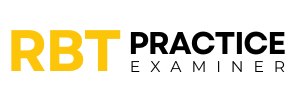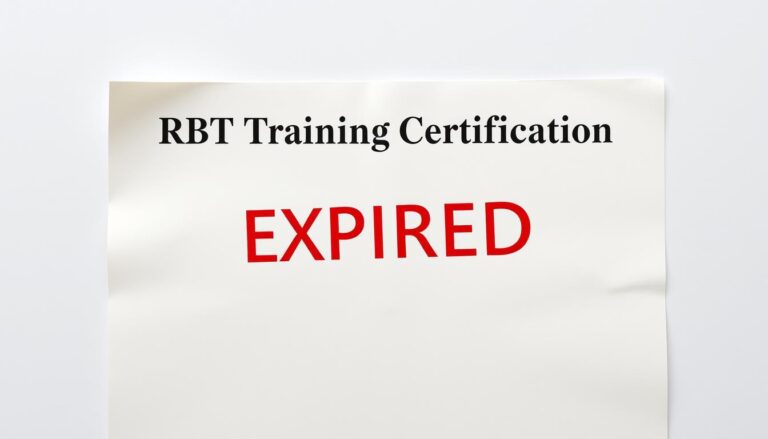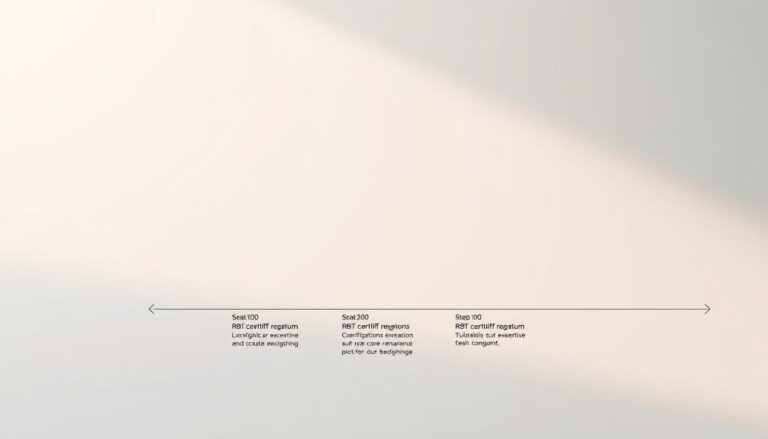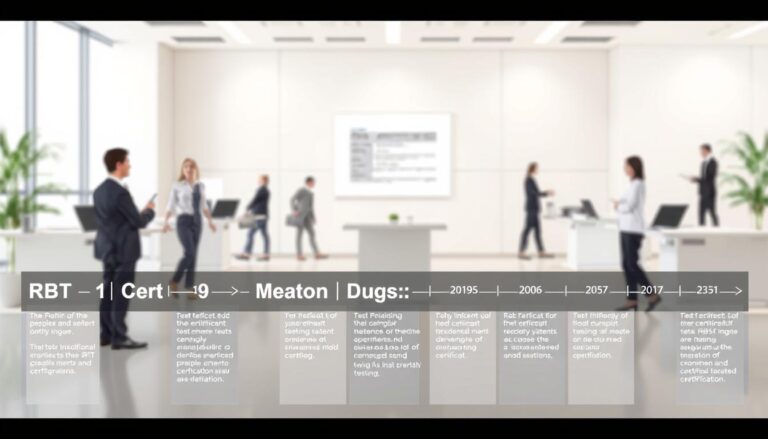RBT Exam Format: Is It Multiple Choice?
Starting your journey to become a Registered Behavior Technician (RBT) means getting to know the exam. Many wonder: is the RBT exam multiple choice? Yes, it is. The exam mainly uses multiple-choice questions to check your skills in applied behavior analysis.
To pass the RBT exam, you need to know a lot about it. You must show you can handle behavior intervention, follow professional rules, and apply strategies in real life. The multiple-choice questions help make sure you have the right skills for working with people with autism and other challenges.
Getting certified by the Behavior Analyst Certification Board (BACB) is tough. The RBT exam tests your ability to use what you know in real situations. Knowing how the exam works is key to doing well and starting a career in behavioral intervention.
Understanding the RBT Exam Structure
To pass the registered behavior technician exam, you need to know its structure well. Getting certified as a behavior technician requires a lot of study and understanding the exam’s design. Here are the main parts to help you feel ready for the test.
Task List Distribution and Categories
The exam is designed to test your skills in several areas. It looks at:
- Measurement and data collection
- Assessment and documentation
- Skill acquisition and behavior reduction
- Professional conduct and ethical considerations
Time Allocation and Sections
The test is long and covers both practical and theoretical knowledge. You’ll face:
- 90 multiple-choice questions
- 2-hour total testing time
- Approximately 75 scored questions
- 15 pilot questions for future test development
Testing Environment Requirements
Knowing the testing environment is key. You’ll need:
- Valid government-issued photo ID
- A comfortable testing center or online proctored setting
- Minimal personal items allowed
- A computer with stable internet (for online testing)
Passing the exam requires good preparation and understanding its structure. Knowing these details helps you show your skills and knowledge.
Is the RBT Exam Multiple Choice?
The Registered Behavior Technician (RBT) exam is a multiple-choice test. It checks if aspiring behavior technicians know their stuff. This format makes sure they really get the basics of behavioral analysis.
Looking into the RBT exam, you’ll find a set of questions that test your skills. The multiple-choice style has its perks:
- It checks your technical knowledge clearly
- Everyone gets judged the same way
- It shows if you really get the big picture
- Scoring is fast and fair
On the exam, you’ll face 75-85 questions. These questions cover important parts of behavioral intervention and professional skills.
| Exam Characteristic | Details |
|---|---|
| Question Type | Multiple Choice |
| Total Questions | 75-85 questions |
| Exam Duration | 2 hours |
| Passing Score | 80% or higher |
The multiple-choice format helps the Behavior Analyst Certification Board. It tests if you know the theory and can apply it in real life.
Key Components of the RBT Certification Test
The Registered Behavior Technician (RBT) exam tests important skills through a detailed multiple-choice format. It’s key to know the RBT exam format well. This includes understanding the main parts that check a candidate’s skills.
Candidates need to show they’re good at many areas of applied behavior analysis. The exam details show a clear way to test their knowledge and skills.
Measurement and Assessment Questions
The measurement section looks at how well candidates collect and understand data. They’ll face questions that check their skills in:
- Recording behavioral observations correctly
- Knowing how to graph data
- Understanding and interpreting data well
- Using measurement strategies in real settings
Behavior Reduction Scenarios
This part tests problem-solving skills through tough scenarios. The RBT exam includes questions that ask candidates to:
- Find the best ways to solve behavior problems
- Know the right ways to respond
- Show they understand ethical ways to intervene
Documentation and Reporting Items
Being good at documentation is very important for RBTs. The exam checks if candidates can:
- Write clear and simple progress reports
- Keep accurate client records
- Talk well with their supervisors
| Exam Component | Skills Assessed | Percentage of Exam |
|---|---|---|
| Measurement | Data Collection | 25% |
| Behavior Reduction | Intervention Strategies | 35% |
| Documentation | Reporting Skills | 40% |
Knowing these areas well helps candidates pass the RBT certification test. It shows they really get the principles of applied behavior analysis.
Breaking Down the Multiple Choice Format

Understanding the RBT exam’s multiple choice questions is key. The test’s structure is unique, designed to check your knowledge and skills in applied behavior analysis.
Most questions are multiple choice, asking you to pick the best answer from several options. Each question has a clear question or scenario, four possible answers, one correct choice, and three wrong ones.
The RBT exam tests your practical knowledge of behavior intervention. You need to show:
- You know a lot about behavior principles.
- You can spot the right intervention strategies.
- You can think critically in complex scenarios.
To do well, focus on these strategies:
- Read each question carefully
- Get rid of obviously wrong answers.
- Use the process of elimination.
- Manage your time well.
| Question Type | Focus Area | Difficulty Level |
|---|---|---|
| Clinical Scenarios | Practical Application | Moderate |
| Behavior Reduction | Intervention Strategies | High |
| Professional Conduct | Ethical Guidelines | Low to Moderate |
Getting good at RBT exam questions takes practice and a strong grasp of behavior analysis. The exam pushes you to show both your theoretical knowledge and how you apply it in real life.
Question Types and Scenarios You’ll Encounter
To pass the RBT exam, you need to know the different types of questions. The exam checks your skills in real-world situations. It uses scenarios that are like what you’ll face in the job.
When getting ready for the RBT exam, it’s key to learn about three main question types. They test your ability to do the job well:
Clinical Vignettes: Practical Application Scenarios
Clinical vignettes are complex situations that need deep thinking. These tips help you show you can:
- Analyze client behavior patterns
- Develop the right strategies for help
- Make choices that are ethical and professional
Direct Implementation Questions
These questions check if you can use behavior analysis in real life. You need to show you can:
- Use specific strategies to help
- Collect and understand data
- Know when to use certain interventions
Professional Conduct Scenarios
Being ethical is very important in the RBT job. These scenarios test your knowledge of professional rules, client rights, and ethics in behavior analysis.
Good study tips for the RBT exam include practicing with sample questions. Also, understand the basics of each scenario and develop a method for solving problems.
Scoring System and Passing Requirements

To pass the RBT exam, you need to know the scoring system well. The test has multiple-choice questions that check your skills in key areas. These questions are designed to see if you can do the job of a Registered Behavior Technician.
The exam scores you based on how well you do in different areas. You must show you’re good at many things to pass. This makes sure you’re ready for the job.
- Total exam questions: 85 multiple-choice items
- Passing score: 80% (approximately 68 correct answers)
- Exam duration: 2 hours
Knowing how the exam is scored helps a lot. It shows how each part of the test works:
| Domain | Percentage of Exam |
|---|---|
| Measurement | 20% |
| Assessment | 15% |
| Skill Acquisition | 25% |
| Behavior Reduction | 25% |
| Professional Conduct | 15% |
Getting ready for the RBT exam is very important. Good preparation helps you understand the scoring system and show you’re ready for the job.
Every question is important, so you need to know all the content. The strict scoring makes sure only the best get certified. This keeps the quality of behavioral services high.
Common Challenges in the RBT Exam Format
Getting ready for the RBT exam can feel overwhelming. There are several big hurdles to overcome. Knowing these challenges is key to doing well on the test and getting certified.
Time Management Strategies
Time management is a big deal when it comes to the RBT exam. Many people find it hard to keep a good pace during the test. This can cause stress and mistakes.
- Practice finishing practice questions on time
- Find a method to read and answer questions efficiently
- Learn to spot important details in scenarios fast
Navigating Complex Scenarios
The test often has tricky scenarios to figure out. You need to be good at finding the main points and using your knowledge right.
- Break down tough scenarios into simpler parts
- Practice spotting key behavioral principles
- Use your critical thinking to figure out the best actions
Overcoming Technical Terminology Barriers
Technical terms can be a big problem for RBT exam takers. The field of behavioral analysis has its own special words that need a lot of study.
- Make flashcards for important terms
- Study glossaries and other resources on technical terms
- Practice using these terms in real situations
By knowing these challenges and using the right study tips, you can feel more confident. Regular practice and smart learning are essential to succeed in the RBT exam format.
Essential Test-Taking Strategies for Multiple Choice Questions

Getting ready for the RBT exam is more than just knowing the material. Learning how to tackle multiple-choice questions is key to passing. It’s not just about knowing the answers, but also how you approach them.
Good RBT exam study tips include a methodical way to handle multiple-choice questions. Always read each question and all options before choosing an answer.
- Read the entire question before looking at answer choices
- Eliminate obviously incorrect answers first
- Use the process of elimination technique
- Manage your time effectively during the exam
If you’re unsure during the RBT exam, stay calm. Don’t panic if you’re unsure about a specific question. Use your knowledge of applied behavior analysis to make a smart guess.
Improving your test-taking skills means practicing under timed conditions. Try practice exams that mimic the real RBT test. This boosts your confidence and lowers anxiety.
- Practice with realistic mock exams
- Review incorrect answers to understand why
- Learn from your mistakes
- Build confidence through consistent preparation
To pass the RBT exam, you need knowledge, strategy, and calmness. By using these test-taking tips, you’ll be ready to handle multiple-choice questions. You’ll show your grasp of behavioral analysis principles.
Computer-Based Testing Platform Overview
Understanding the digital testing environment is key to navigating the RBT exam. The RBT exam format uses a user-friendly computer platform. It aims to make the testing experience smooth for candidates.
The digital testing interface has many features to help candidates feel at ease. It’s designed to boost their confidence during the exam.
Navigation Features
Candidates will find an easy-to-use navigation system. It has several important features:
- Straightforward question movement using forward and backward buttons
- Clear section indicators showing overall exam progress
- Time tracking display in real-time
- Simple interface with minimal distractions
Question Review Capabilities
The RBT exam format has strong review tools. These tools help test-takers manage their strategy effectively:
- Question flagging for later review
- Easy return to marked questions
- Ability to change answers within allocated time
Knowing about these features can help reduce test anxiety. It can also improve performance during the exam.
| Platform Feature | Functionality | Benefit |
|---|---|---|
| Navigation Controls | Simple question movement | Reduces navigation stress |
| Time Tracker | Real-time progress display | Helps manage exam time |
| Review Options | Flag and revisit questions | Improves answer accuracy |
Preparing for Different Question Formats
Getting ready for the RBT exam means learning how to handle different question types. You need to study hard and use the right study methods for multiple-choice questions.
When you’re studying for the RBT exam, it’s important to get good at different question types. The exam has many kinds of questions. These questions check if you really get the basics of applied behavior analysis.
- Single correct answer multiple-choice questions
- Scenario-based questions
- Professional conduct scenarios
- Practical implementation questions
Here are some tips to help you prepare well:
- Go over practice test materials carefully
- Work on your critical thinking skills
- Practice managing your time
- Make sure you understand the main ideas
To do well on your RBT exam practice tests, check out these resources:
| Resource Type | Recommended Materials | Focus Area |
|---|---|---|
| Online Practice Tests | Behavior Analyst Certification Board (BACB) approved materials | Comprehensive exam preparation |
| Study Guides | Professional ABA training manuals | Detailed content review |
| Interactive Courses | Virtual training platforms | Real-world scenario practice |
Pro tip: It’s more important to understand why each answer is right than just to memorize them. This way, you’ll feel more confident when facing tough questions.
RBT Exam Updates and Changes
It’s important for those aiming to be RBTs to keep up with exam updates. The RBT exam format changes often. This is because behavioral health practices and research in applied behavior analysis are always evolving.
The Behavior Analyst Certification Board (BACB) regularly updates the RBT exam. They do this to make sure the exam stays at the top level of professional standards and client care.
Recent Format Modifications
Recent changes to the RBT exam include:
- More focus on ethics
- New question types that show the latest best practices
- More questions based on real-life scenarios
Future Implementation Plans
Future changes to the RBT exam will focus on several key areas:
| Area of Focus | Proposed Changes |
|---|---|
| Digital Assessment | More advanced computer-based tests |
| Content Depth | More on advanced behavioral strategies |
| Professional Competencies | More on skills used in real-world settings |
Candidates should regularly check the official BACB website for the latest on the exam. Knowing about these updates helps prepare better for the certification process.
Testing Accommodations and Special Arrangements
Getting ready for the RBT exam can be tough, even more so for those with special needs. The Behavior Analyst Certification Board (BACB) wants to make sure everyone has a fair chance. They aim to provide equal testing opportunities for all.
Those needing special help must go through a certain process. The main goal is to make sure everyone can show what they know best.
- Documented disabilities qualify for possible accommodations
- Request must be sent early before the exam date
- Full medical documentation is needed
For those with special needs, here are some options to consider:
- Extended testing time
- A room just for you
- Tools to help with tests
- Sign language interpreters
- Other ways to take the test
The steps to ask for accommodations are:
- Write a formal request
- Send in medical proof
- Wait for them to review and say yes
- Get a confirmation of what you’ll get
If you need help, reach out to the BACB. Talking early and being proactive is key to getting the right setup for your test.
Conclusion
Getting ready for the RBT exam needs a smart plan, knowing it’s mostly multiple-choice. Learn about the exam’s layout and types of questions to feel more confident. Success comes from studying well and knowing behavior analysis inside out.
When you’re getting ready for the RBT exam, it’s important to really get the task list and clinical scenarios. Yes, the RBT exam is multiple choice, so you need to think critically, not just memorize. Use practice tests and study materials to get better at the tricky questions you’ll see.
Working towards becoming a Registered Behavior Technician is tough but worth it. Showing you’re serious about the RBT exam shows you’re serious about growing in applied behavior analysis. By mastering the multiple-choice questions and understanding key skills, you’re on your way to a fulfilling career helping people with behavioral issues.
This certification is more than a test; it’s a chance to really help people. Stay focused, keep practicing, and go into the exam with confidence. Your career in behavior analysis begins with hard work and a desire to help others.







